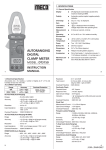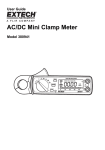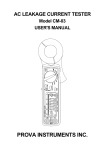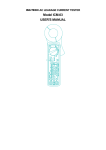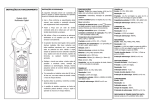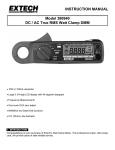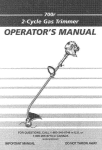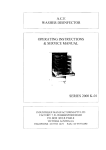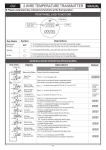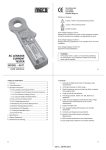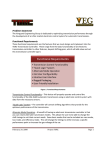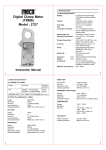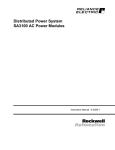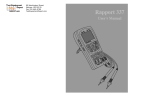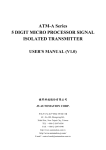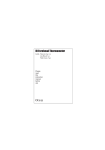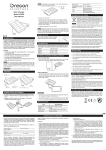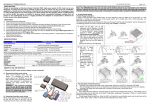Download DIGITAL CLAMP ON METER MODEL : 3600
Transcript
®
SAFETY INFORMATION
The following safety information must be observed to insure
maximum personal safety during the operation at this
meter:
1. Do not use the meter if the meter or test leads look
damaged, or if you suspect that the meter is not
operating properly.
2. Use caution when working above 60V dc or 30V ac
rms. Such voltages pose a shock hazard.
3. When Using the probes, keep your fingers behind the
finger guards on the probes.
4. Measuring voltage which exceeds the limits of the
clamp meter may damage the meter and expose the
operator to a shock hazard. Always recognize the meter
voltage limits as stated on the front of the meter.
5. If the equipment is used in a manner not specified
by the manufacturer, the protection provided the
equipment may be impaired.
DIGITAL
CLAMP ON
METER
MODEL : 3600
1
USER MANUAL
2
SPECIFICATIONS
DC VOLTS
Display : 3¾, digit (4000 counts), 9999 counts (Frequency
mode), 40 segments analog bar graph and function units
sign annunciators
Ranges
Resolution
Accuracy (ranges)
Polarity : Automatic, positive implied, negative polarity
indication.
Overrange : “4000 “or”-4000" Most Significant Digit blinks.
Low battery indication : the “
” is displayed when
the battery voltage drops below the operating level.
Measurement rate : 2/sec, nominal. 1/sec, Capacitance
and Frequency mode. 20/sec, Analog display.
Operating Environment : 00C to 400C at < 70% relative
humidity.
Storage Temperature : -200C to 600C, 0 to 80% R.H. with
battery removed from meter.
Accuracy : Stated accuracy at 230C + 50C, <75% relative
humidity.
Safety : According to EN61010-1 protection class II overvoltage category (CAT III 600V) pollution degree 2.
Auto Power off : 30minutes after rotary switch or mode
changes.
Clamp jaw : According to EN61010-2-032 CAT IV 600V.
Power : single standard 9-volt battery, NEDA 1604, JIS
006P, IEC 6F22.
Battery life : 150 hours typical with carbon-zinc.
Dimensions : 250mm (H) x 100mm (W) x 46mm (D).
Weight : Approx. 380g including battery.
Accessories : One pair test 1eads, 9V battery (installed).
3
: 400mV, 4V, 40V, 400V, 600V
: 100mV
: ±(0.25% rdg + 1dgt) on 400mV to
400V
±(0.25% rdg + 3dgts) on 600V
Input impedance
: > 10MV
Overload protection : 600VDC or AC rms
AC VOLTS (True RMS) (50Hz-500Hz)
Ranges
Resolution
Accuracy
: 4V, 40V, 400V, 600V
: 1mV
: ±(0.75% rdg + 4dgts) on 50-60Hz
±(2.0% rdg + 4dgts) on 40-500Hz
Input impedance
: > 10MV
Effect Reading
: 100 - 3999
Overload protection : 600VDC or 600VAC rms
RESISTANCE
Ranges
: 400V, 4KV, 40KV, 400KV,
4000KV, 40MV
Accuracy (ranges) : ±(0.3% rdg + 5dgts) on 400V
±(0.3% rdg + 1dgt) on 4KV to
400KV
±(0.5% rdg + 1dgt) on 4000KV
±(2.0% rdg + 4dgts) on 40MV
Open circuit volts : 0.4Vdc
Overload protection : 600VDC or AC rms
4
CONTINUITY
Audible indication : less than 40V±20V
Overload protection : 600VDC or AC rms
DIODE TEST
Test current
Accuracy
Open circuit volts
Overload protection
: 1.0mA + 0.6mA
: +(3.0% rdg + 3dgts)
: 3.0Vdc typical
: 600VDC or AC rms
DC CURRENT (Put conductor at the center of the
jaws)
Ranges
: 400A, 1200A
Resolution
: 100mA
Accuracy
*700A to 1200A
: ±(1.5% rdg + 5dgts)
: ±(2.0% rdg + 5dgts)
Overload protection : 1200Adc max. for 1 minute.
FREQUENCY (Autoranging)
AC CURRENT (True RMS) (40Hz-500Hz) (Put conductor at the center of the jaws)
Ranges
Ranges
: 400A, 1000A
Resolution
: 100mA
Accuracy
: ±(1.75% rdg + 5dgts) on
50Hz-60Hz
: 100Hz, 1kHz, 10kHz, 100kHz,
500kHz
Resolution
: 0.01Hz
Accuracy
: +(0.1% rdg + 2dgts)
Sensitivity
: 2.0Vrms min
Effect reading
: 10-9999
Overload protection : 600VDC or AC rms
±(3.5% rdg + 5dgts) on
40Hz-500Hz
CAPACITANCE
Ranges
Accuracy
: 4nF, 40nF, 400nF, 4mF, 40mF
: ±(3.0% rdg + 20dgts) on4n
Frange(use DZERO)
±(3.0% rdg + 4dgts) on 40nF to
20mF ranges
±(6.0% rdg + 4dgts) above 20mF
*700A to 1000A
(50Hz/60Hz)
: ±(2.5% rdg + 5dgts)
Overload protection : 1000Aac max. for 1 minute.
Overload protection : 600VDC or AC rms
5
6
OPERATION
MIN / MAX button
Before taking any measurements, read the Safety Information Section. Always examine the instrument for damage, contamination (excessive dirt, grease, etc.) and defects. Examine the test leads for cracked or frayed insulation. If any abnormal conditions exist do not attempt to make
any measurements.
Press (MIN / MAX) button to enter the MIN MAX Recording
mode. The minimum, maximum values are then reset to
the present input, the readings are stored in memory, and
the ”HOLD” annunciator turns on. Push the button to cycle
through the minimum (MIN) ”maximum (MAX), and present
readings. The MIN or MAX annunciator turns on to indicate
what value is being displayed.
H Button
Press “ H ” button to toggle in and out of the Data Hold
mode, except if you are already in the MIN MAX Recording mode.
In the Data Hold mode, the “HOLD” annunciator is displayed and the last reading is held on the display, the beeper
emits a tone. Pressing (MIN / MAX) button when you are in
the Data Hold mode causes you to exit Data Hold and enter the MIN MAX Recording mode.
In the MIN MAX Recording mode, press (HOLD) button to
stop the recording of readings, press (HOLD) again to resume recording.
PEAK HOLD Button : (only AC current ranges 40-60Hz)
Press “PEAK” button two times to toggle in and out of PEAK
Hold mode. In the PEAK Hold mode, the “HOLD P ”
annunciator is displayed. {Accuracy : ± [10% (readind - residual offset) + 10dgts], effect reading : 80 ~ 4000}
7
In the MIN MAX Recording mode, press (HOLD) button to
stop the recording of readings, press again to restart
recording. If recording is stopped, the minimum, maximum,
or present values and analog display are frozen. In the
MIN MAX Recording mode, when a new minimum value is
exceed the actual minimum readings or a new maximum
value is overload, the minimum or maximum value will held
on the display, but the analog display continues to be active.
AC current ranges without MIN/MAX function.
D ZERO Button
Press (DZERO) button to enter the Relative mode, the
”DZERO” annunciator turn on, zero the display, and store
the displayed reading as a reference value. Press and hold
down the (DZERO) button for 2 seconds to exit the relative
mode.
8
RANGE Button
Current Measurements
Press (RANGE) button to select the Manual Range mode
and turn off the “AUTO” annunciator. (The meter remains
in the range it was in when manual ranging was selected).
1. Set the Function/Range switch to the desired highest
1000AAC or 1200A DC range. In DC current
measurement use DZERO button, offset the residual
magnetic of the jaws.
In the Manual Range mode. each time you press (RANGE)
button, the range (and the input range annunciator)
increments, and a new value is displayed. To exit the
Manual Range mode and return to autoranging, press and
hold down (RANGE) button for 2 seconds. The “AUTO”
annunciator turns back on.
Voltage Measurements
1. Connect the red test lead to the “V” jack and the black
test lead to the “COM” jack.
2. Set the Function/Range switch to the desired voltage
range (AC or DC). The meter will automatically select
the best voltage range.
3. Connect the test leads to the device or circuit being
measured.
4. For dc, a (-) sign is displayed for negative polarity;
positive polarity is implied.
2. Press the trigger to open transformer jaws and clamp
onto one conductor only. Read the current directly on
the display. It is recommended that the conductor be
placed at the center of the closed jaws for maximum
accuracy.
3. When the reading is lower than 400 counts, set the range
switch to the next lower range position. For maximum
accuracy, select the lower range possible without
overranging the meter.
Resistance Measurements
1. Set the Function/Range switch to the resistance range.
2. Remove power from the equipment under test.
3. Connect the red test lead to the “ + ” jack and the black
test lead to the “COM” jack.
4. Touch the probes to the test points. In ohms, the value
indicated in the display is the measured value of
resistance.
WARNING
The accuracy of the functions might be slightly affected,
when exposed to a radiated electromagnetic field
environment, e.g. radio, telephone or similar.
9
10
Continuity Measurements
1. Set the Function/Range switch to the “
Capacitance Measurements
” position.
2. Remove power from the equipment under test.
3. Connect the red test lead to the “ + ” jack and the black
test lead to the “COM” jack.
4. Touch the probes to the test points. the beeper sounds
continuously, if the resistance is less than 40V.
1. Set the Function/Range switch to the “
” range.
2. Connect the test leads to the “ + ” jack and the black test
lead to the “COM” jack.
3. Connect the red test lead to the capacitor and read the
capacitance directly from the display.
MAINTENANCE
Diode Tests
1. Connect the red test lead to the “ + ” jack and the black
test lead to the “COM” jack.
2. Set the Function/Range switch to the “
WARNING
Remove test leads before changing battery or
performing any servicing.
” position.
3. Turn off power to the circuit under test.
Battery Replacemeat
4. Touch probes to the diode. A forward-voltage drop is
about 0.6V (typical for a silicon diode).
Power is supplied by a 9 volt “transistor” battery. (NEDA
1604, IEC 6F22). The “
” appears on the LCD display
when replacement is needed. To replace the battery,
remove the two screws from the back of the meter and
lift off the battery cover. Remove the battery from battery
contacts.
5. Reverse probes. If the diode is good, “4000” is displayed.
If the diode is shorted, “.000” or another number is
displayed.
6. If the diode is open, “4000” is displayed in both directions.
Frequency Measurements
1. Set the Function/Range switch to the Hz position.
Cleaning
Periodically wipe the case with a damp cloth and
detergent, do not use abrasives or solvents.
2. Connect the red test lead to the “ + ” jack and the black
test lead to the “COM” jack.
3. Connect the test leads to the point of measurement and
read the frequency from the display.
11
12
®
FRONT PANEL CONTROLS
2-1
2-4
2-3 2-5
2-9
2-10
2-7
2-6
2-2
DC / AC
CLAMP METER
MODEL :
3690AUTO
USER MANUAL
1
2-8
,
lnput Terminal : This terminal is used as
VV, Hz,
input for voltage, ohm, continuity, diode and frequency
measurement.
2-9
COM Terminal : This terminal is used as common reference
input.
2-10
Hz / Duty Button
2-11
Range Button
2-12
Select Button
2-12
2-8
2-1
Transformer Jaw : This is used to sense the current
signal. To measure DC/AC current, conductor must be
enclosed by the jaw.
2-2
Transformer Trigger : This is used to open the jaw.
2-3
Function selector switch : This is use to select the function
v , ohm, continuity, diode
user desired such as DCA, ACA, ~
and Hz.
2-4
Data Hold Button
2-5
Zero Button
2-6
LCD : This is a 3¾ digit liquid crystal display with maximum
indication of 4000 counts.
2-7
Low Battery Symbol : When this Symbol appears, it
means the battery voltage drops below the minimum
required voltage. Refer to section V for batter y
replacement.
2
1. SPEClFICATlONS
1.1 General Specifications
Display
Zero adjustment
Over range indication
: 3¾ digit liquit crystal display (LCD)
Max reading 4000 counts
: Automatic, Positive implied,
(-) negative polarity indication
: Automatic
: "OL" or "-OL"
Low battery
Sample rate
Operating conditions
: “
” mark turns on.
: 3 times per second, nominal
: O0C to +500C at > 75% RH
Polarity
Storage conditions
Accuracy
Power Supply
Battery Life
Dimensions
Weight
Accessories
Max. Jaw Opening
3
2-11
(Noncondensing)
: -200C to +600C, 80% RH with
battery removed
: Accuracy specification at 270C
± 50C less than 75% RH.
: Two 1.5 V AAA size battery
: 150 hours typical with carbon
zinc
: 215mm (H) x 80mm (W) x
40 mm(D)
: 280 gms (approx.)
: one pair of test leads.
Two 1.5 V AAA size battery
(installed),
Instruction manual.
: 30mm
4
1.2 Electrical Specification
DC CURRENT :
Range
Accuracy
400A
± (1.5% rdg ± 5 dgts)
600A
± (2.0% rdg ± 5 dgts)
Overload Protection
1200A DC Max.
for 1 minute
AC CURRENT :
Range
400A
600A
Accuracy
50 - 60Hz
40 - 500Hz
± (1.75% rdg ± (3.5% rdg
± 5 dgts)
± 5 dgts)
Overload Protection
1000A AC Max.
for 1 minute.
AC Voltage (Auto Ranging)
Range
: 4V, 40V, 400V, 600V
Resolution
: 1mV to 1V
Accuracy
: ± (1.2 % rdg + 4 dgts ) on 50 - 60 Hz
± (2% rdg + 25 dgts) on 40 - 500Hz
± (4% rdg +5dgts ) on 600v
Input impedance
: >10MV
Over load protection
: 600V DC or 600V AC rms.
DC Voltage (Auto Ranging )
Range
: 400mV, 4V, 40V, 400V, 600V
Resolution
: 0.1mV to 1V
Accuracy
: ± (0.5 % rdg + 8 dgts) on
400mV to 400V
± (0.7 % rdg +2 dgts ) on 600V
Input impedance
: >10MV
Over load protection
: 600V DC or 600V AC rms.
Resistance (auto ranging)
Range
: 400V, 4KV, 40KV, 400KV, 4MV,
40MV
Resolution
: 0.1V to 0.01MV
Accuracy
: ± (0.75% rdg + 8 dgts) on 400V to
400KV
± (1.0 % rdg +6 dgts) on 4MV
± (2-0 % rdg +4 dgts) on 40MV
Open Circuit Volts
: 0.4V DC
Over load protection
: 600V DC or AC rms.
Diode test
Test Current
: 1.0 mA ± 0.6 mA
Accuracy
: ± (3.0% rdg + 3 dgts) only for refrence
Open circuit volts
: 3.0V DC typical.
Overload protection
: 600V DC or AC rms.
Continuity
Audiable indication
: less than 40V ± 20V
Overload protection
: 600V DC or AC rms.
Frequency (Auto Ranging)
Ranges
: 100Hz, 1KHz, 10KHz, 100KHz,
500KHz
Resolution
: 0.1 Hz to 0.1 KHz
Accuracy
: ± (0.3 % rdg + 2 dgts)
Sensitivity
: 3.0V rms min.
Effect reading
: 10 - 9999
Overload protection
: 200V DC or AC rms.
% Duty Cycle (auto ranging)
Range
: 1% to 90 %
Accuracy
: ± (0.5 % rdg + 5 dgts)
Resolution
: 0.1 %
Overload protection
: 200V DC or AC rms.
6
2. OPERATlON
A. DC/AC Current Measurements.
1. Before taking only measurements, read the safety in
information section. Always examine the instrument for
deamage, contamination (excessive dirt, grease, etc.) and
defeets. Examine the test leads for cracked or frayed insulation.
If any abnormal conditions exist do not at ettempt to make
any measurement.
7. WARNING : Make sure that all the test leads are disconnected
from the meter’s terminal for current measurement.
2.
Data Hold Button :
Press data hold button to toggle in and out of data hold mode,
in the data hold mode, the " HOLD " annunciator is displayed.
3.
4.
Select Button :
v
In ~ Range it will select DCV or ACV function in V,
,
range it will select resistance or diode or continuity function.
Range Button :
Press (Range) button to select the manual range mode and
turn off the ‘Auto’ annunciator (The meter remains in the range
it was in when manual ranging was selected).
In the manual range mode. Each time you press (Range)
button, the range (and the input range annunciator) in crements
and a new value is displayed. To exit the manual range mode
and return to autoranging, press and hold down (Range) button
for 2 seconds. The ‘auto’ annunciator turns back on.
5.
Zero Button :
Press (Dzero) button to enter the relative mode the ‘Dzero’
annunciator turn on zero the display, and store the displayed
reading as a refrenece value, press and hold down the (Dzero)
button for 2 seconds to exit the reative mode.
6.
Hz / Duty Button :
In ACV range it will select ACV / HZ / Duty function in Hz
range it will select Hz / Duty function.
7
8.
DC Current :
a) Set the rotary switch at DCA range.
b) Push the zero button to stop the reading at zero for one
second If the reading is not stopped at zero, release the
button a while and push it again.
c) Press the trigger to open the jaw and fully enclose the
conductor to be mesured. No air gap is allowed between
the two half jaws.
d) Read the measured value from the LCD display.
e) Make sure that the offset value caused by the residual
magetism is still removed. If the new offset value is
produced, remove it with the zero button and make a new
measurement again according to the "c" & "d". (If the
current to be measured is larger than the current measured
before, or the direction of current changes. the new offset
value will be produced.)
9. AC Current :
a) Set the Function/Range switch to the ACA range.
b) Press the trigger to open transformer jaws, clamp onto
completely closed,Read the current directly on the display,
It is recommended that the conductor be placed at the
center of the close jaws for maximum accuracy.
B. DC/AC Voltage Measurements.
10. WARNING : Maximum input for DCV is 600V and for ACV is
600V Do not attempt to take any voltage measurement that
exceeds the limits. Exceeding the limits could couse electrical
shock and damage to the clamp meter.
8
14. Diode :
11. DC Voltage :
v
a) Set the rotary switch at ~ range.
a) Set the rotary switch at V,
b) Select
c) Insert the test lead in to the input jack.
e) Touch probes to the diode A forward voltage drop is about
0.6V (typical for a silicon diode)
v
a) Set the rotary switch at ~ range
f)
b) Select ACV by pressing selcet button .
If the digital display reads over range "OL" reverse the
lead connections. The placement of the test leads when
the forweard reading is displayed indicates the orientation
of the diode. The red lead is positive and the black lead is
negative. If overrange "OL" is display with both lead
connection, the juction is open, if a low reading (less than
1000) is obtained with both lead conncetion, the junction
is shorted internally or (if junction is measured in a circuit)
the junction is shunted by a resistance less than 1kV in
the letter case the junction must be disconnected form
the circuit in order to verify its opertion.
c) Insert the test tead in to the input jack.
d) Connect the test probe in parallel to the circuit to be
measured.
e) Read the measured value form the LCD display.
WARNING : Before taking any in-circuit resistance measurement
remove power from the circuit being tested and discharge all the
capacitors.
13. Resistance :
a) Set the rotary switch at V,
by pressing select button.
d) Trun off power to the circuit under test.
12. AC Voltage :
,
range.
15. Continuty :
b) Insert the test lead in to the input jack.
a) Set the rotary switch at V,
c) If the resistance being measured is connected to a circuit,
turn off power to the circuit being tested and discharge all
the capacitors.
d) Connect test lead across the resistance being measured.
When meansuring high resistance, be sure not contact
adjacent points even if insulated because some insulator
have a relatively low insulation resistance, causing the
measured resistance to be lower than the actual
resistance.
b) Select
a) Set the rotary switch at Hz range.
b) Insert the test lead in to the input jack.
c) Connect the test lead to the points of measurement and
read the frquency form the display.
10
3) Select ACV range by pressing select button.
4) Select frequency or duty cycle by pressing 'Hz / Duty'
button.
b) Select duty cycle by pressing Hz / Duty button.
5) Connect the test leads across the source or load under
measurment.
c) Insert the test lead in to the input jack.
There are 2 positions for frequency & duty cycle measurment.
a) 'Hz' position (not for line frequency measurement)
b) 'ACV' position (for line frequency measurement)
by pressing select button.
16. Frequency :
a) Set the rotary switch at Hz range.
18. Frequency & Duty Cycle measurement :
range.
d) Connect the test lead to the test points the beeper sounds
conninuosly. If the resistance is less than 40V
e) Read resistance value on digital display. If a high resistance
value is shunted by a large value of capacitace allow
display to stabilize.
d) Conncet the test lead to the points of measured and read
duty cycle from the display
,
c) Insert the test lead in to the input jack.
17. Duty Cycle :
3. MAINTENANCE
WARNING :
Remove test leads before changing battery performing any
servicing. Never operate instrument unless bottom cover is closed.
TROUBLE SHOOTlNG
Sensitivity : 3V
If there appears to be s malfunction during the operation of the
meter, the following steps should be performed in order to isolate
the cause of the problem :
Frequency range : 100 Hz to 500KHz
1. Check the battery.
Duty cycle : 1% to 90 %
2. Review the operating instructions for possible mistakes in
operating procedure
a) 'Hz' position (not for line frequency measurment)
Overload protection : 200V DC or AC peak
1) Set the rotary switch at Hz
2) Connect test lead in to the input jack.
3) Select frequency or duty cycle by pressing ‘Hz / Duty’
button.
4) Connect the test leads across the source or load under
measurement
a) 'ACV' position (for line ferquency, measurement).
Sensitivity : 2V
Ferquency range : 40 Hz to 500Hz
Duty cycle : 10% to 90%
11
range.
c) Connect the test probe in parallel to the circuit to be
measured.
d) Read the measured value from the LCD display.
9
,
b) Insert the testleads into the input jack.
Overload protection : 1000V DC or 750V AC peak.
1) Set the rotary switch at V
~
2) Connect test lead in to the input jack.
3. Inspect and test the Test Probes for a broken or intermittent
connection.
BATTERY REPLACEMENT
When the low battery symbol is displayed on LCD, replace the old
battery with new battery.
A. Turn the power off and remove the test leads from the clamp
meter.
B. Remove the screw of the battery compartment.
C. Slide off the battery compartment.
D. Remove the old battery
E. Insert new battery.
F.
○
Replace the battery compartment and secure the screw.
○
○
○
○
○
○
○
○
○
○
○
○
○
○
○
○
○
○
○
○
○
○
○
○
○
○
12
○
®
PRECAUTION
1. Observe all safety rules while making measurements.
CAUTION should be exercised when making measurements
since dangerous voltages can be present in normally safe
circuit or areas.
2. If this instrument is NOT going to be operated for an extended
period remove the battery since damage can result from
leakage.
4. SAFETY RULES
The following safety information must be observed to ensure
maximum personal safety during the operation of this meter
1. Do not use the meter if the meter or test leads look damaged.
or if you suspect that the meter is nat operating properly.
2. This clamp meter is designed to take current measurements
on circuit with a maximum voltage difference of 500VAC
between any conductor and ground potential. Using the
instrument for current measurements on circuit above this
voltage may cause electric shock, instrument damage or
damage to the equipment under test.
3. Turn off power to the circuit under test before cutting,
unsoldering, or breaking the circuit. Small amounts of current
can be dangerous.
4. Use caution when working above 60V DC or 30V AC rms.
Such Voltages pose a shock hazard.
5. When using the probes, keep your fingers behind the finger
guards on the probes.
6. Measuring voltage which exceeds the limits of the clamp meter
may damage the meter and expose the operator to a shock
hazard.
Always recognize the meter voltage limits as stated on the
meter.
13
Certificate of Calibration
We hereby cer tify that this product has been
calibrated and found to be in accordance
with the applicable SPECIFICATIONS and
STANDARDS.
Accuracies of the standard equipment used in
this calibration are traceable to the National
Standards.
MECO METERS PVT. LTD.
Block 9, Plot 270, 2nd Floor, Rup-Udey Niwas,
Sion (E), Mumbai - 400 022 (INDIA)
Correspondance Address :
Plot No. EL-1, MIDC Electronic Zone, TTC Industrial
Area, Mahape, Navi Mumbai - 400710 (INDIA)
Tel : 0091-22-27673311-16, 27673300 (Board)
Fax : 0091-22-27673310, 27673330
E-mail : [email protected]
Web : www.mecoinst.com
SR. NO.
:
CHECKED BY :
DATE
:
MODEL NO.
:
14
NOTE
NOTE
○
○
○
○
○
○
○
○
○
○
○
○
○
○
○
○
○
○
○
○
○
○
○
○
○
○
○
○
○
○
○
○
○
○
○
○
○
○
○
○
○
○
○
○
○
○
○
○
○
○
○
○
○
○
○
○
○
○
○
○
○
○
○
○
○
○
○
○
○
○
○
○
○
○
○
○
○
○
○
○
○
○
○
○
○
○
○
○
○
○
○
○
○
○
○
○
○
○
○
○
○
○
○
○
○
○
○
○
○
○
○
○
○
○
○
○
○
○
○
○
○
○
○
○
○
○
○
○
○
○
○
○
○
○
○
○
○
○
○
○
○
○
○
○
○
○
○
○
○
○
○
○
○
○
○
○
○
○
○
○
○
○
○
○
○
○
○
○
○
○
○
○
○
○
○
○
○
○
○
○
○
○
○
○
○
○
○
○
○
○
○
○
○
○
○
○
○
○
○
○
○
○
○
○
○
○
○
○
○
○
○
○
○
○
○
○
○
○
○
○
○
○
○
○
○
○
○
○
○
○
○
○
○
○
○
○
○
○
○
○
○
○
○
○
○
○
○
○
○
○
○
○
○
○
○
○
○
○
○
○
○
○
○
○
○
○
○
○
○
○
○
○
○
○
○
○
○
○
○
○
○
○
○
○
○
○
○
○
○
○
○
○
○
○
○
○
○
○
○
○
○
○
○
○
○
○
○
○
○
○
○
○
○
○
○
○
○
○
○
○
○
○
○
○
○
○
○
○
○
○
○
○
○
○
○
○
○
○
○
○
○
○
○
○
○
○
○
○
○
○
○
○
○
○
○
○
○
○
○
○
○
○
○
○
○
○
○
○
○
○
○
○
○
○
○
○
○
○
○
○
○
○
○
○
○
○
○
○
○
○
○
○
○
○
○
○
○
○
○
○
○
○
○
○
○
○
○
○
○
○
○
○
○
○
○
○
○
○
○
○
○
○
○
○
○
○
○
○
○
○
○
○
○
○
○
○
○
○
○
○
○
○
○
○
○
○
○
○
○
○
○
○
○
○
○
○
○
○
○
○
○
○
○
○
○
○
○
○
○
○
○
○
○
○
○
○
○
○
○
○
○
○
○
○
○
○
○
○
○
○
○
○
○
○
○
○
○
○
○
○
○
○
○
○
○
○
○
○
○
○
○
○
○
○
○
○
○
○
○
○
○
○
○
○
○
○
○
○
○
○
○
○
○
○
○
○
○
○
○
○
○
○
○
○
○
○
○
○
○
○
○
○
○
○
○
○
○
○
○
○
○
○
○
○
○
○
○
○
○
○
○
○
○
○
○
○
○
○
○
○
○
○
○
○
○
○
○
○
○
○
○
○
○
○
○
○
○
○
○
○
○
○
○
○
○
○
○
○
○
○
○
○
○
○
○
○
○
○
○
○
○
○
○
○
○
○
○
○
○
○
○
○
○
○
○
○
○
○
○
○
○
○
○
○
○
○
○
○
○
○
○
○
○
○
○
○
○
○
○
○
○
○
○
○
○
○
○
○
○
○
○
○
○
○
○
○
○
○
○
○
○
○
○
○
○
○
○
○
○
○
○
○
○
○
○
○
○
○
○
○
○
○
○
○
○
○
○
○
○
○
○
○
○
○
○
○
○
○
○
○
○
○
○
○
○
○
○
○
○
○
○
○
○
○
○
○
○
○
○
○
○
○
○
○
○
○
○
○
○
○
○
○
○
○
○
○
○
○
○
○
○
○
○
○
○
○
○
○
○
○
○
○
○
○
○
○
○
○
○
○
○
○
○
○
○
○
○
○
○
○
○
○
○
○
○
○
○
○
○
○
○
○
○
○
○
○
○
○
○
○
○
○
○
○
○
○
○
○
○
○
○
○
○
○
○
○
○
○
○
○
○
○
○
○
○
○
○
○
15
○
16
○







